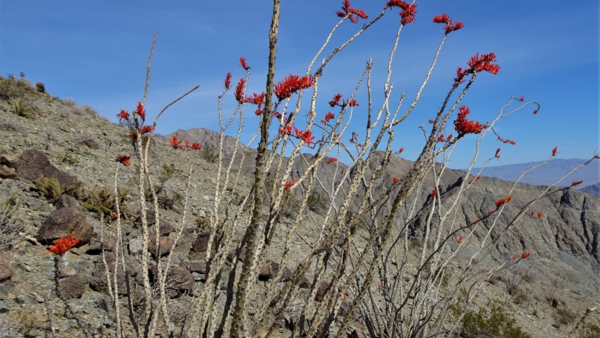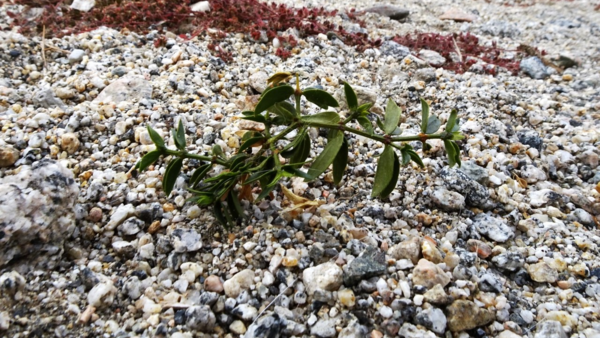The biological significance of summer rains
“Without rain, there is no life." — Jerry Yang
During these late fall and winter months, you can often look toward the mountains and see snow capping the peaks, reminding us of the winter season even when it can be 80 degrees here on the desert floor. Take a closer look and you will see that San Gorgonio has more snow than San Jacinto, and it has more snow than Toro Peak in the Santa Rosa Mountains. It has been that way as long as people can remember and well before there were any people here to take notice. The San Jacinto mountains have black oaks, alders, and box elders; none of those occur in the Santa Rosa Mountains. San Gorgonio Peak used to have a glacier; the San Jacinto and Santa Rosa Mountains never did. Different levels of moisture, rain and snow, and perhaps especially snow, explain these patterns.
But things are changing. San Gorgonio used to hold on to some snow well into the summer. Hikers could always depend on melting snow to cook their dinner or to make oatmeal for breakfast. That is no longer the case; summer hikers must bring water with them. Toro Peak used to be clad in snow all winter long, but now the snow only lasts for a few days. Those early naturalists could find flowing water from springs throughout the north facing canyons of the Santa Rosa Mountains, but no longer. There is at least a couple dozen natural palm oases in the Santa Rosa Mountains, each established because there was year-round water at or very near the surface. That is the only way palm seeds can germinate. All are now dry all year long. Increasing droughts and associated declining mountain aquifers are the clearest examples we have of a changing climate.
Summer rain, monsoons, are almost the reverse pattern. The Santa Rosa Mountains have ocotillo, a species requiring summer rain to germinate. By mapping the extent of ocotillo, you can map the regions where summer rain is most dependable. The Anza Borrego portion of the Colorado Desert, the south-facing slopes of Santa Rosa and Toro Peaks and then south into Baja California have dense groves of ocotillo. The stands of ocotillo then wrap around the east facing slopes of Sheep Mountain, Martinez Mountain and then west along the north facing slopes above La Quinta, Indian Wells, and Palm Desert. And then they stop almost if there was an invisible fence that proclaimed no ocotillos allowed beyond this point. Further west above Rancho Mirage, Cathedral City, and then Palm Springs there are no ocotillo. Nor are there ocotillo on the San Bernardino Mountains below San Gorgonio Peak. Presumably the summer rains there are not dependable enough to support ocotillo.
Ocotillos, Fouquieria splendens, are the most northern member of the family Fouquieriaceae. This plant has quite a number of charming names: candlewood, slimwood, coachwhip, vine cactus, flaming sword, and jacob's staff. but most folks call it ocotillo. Often confused as being related to cacti due to the prominent spines, ocotillo has a closer kinship with blueberries and tea. There are 11 different species within Fouquieriaceae, all confined to Mexico and the southern U.S., and all are dependent on summer rain. Four different species of Fouquieriaceae are found in Baja California, including the largest one, the boojum, Fouquieria columnaris. Boojums look much like an enormous 40-foot-tall upside-down gray-green carrot, some with a base diameter of more than a meter across. Among the first non-indigenous people to see a boojum, Godfrey Sykes of the Desert Laboratory in Tucson, AZ., christened this species as a boojum, based on the Lewis Carroll poem the “Hunting of the Snark” in which “boojums” occupied the farthest ends of the Earth. Sykes apparently felt anything as bizarre as this species must only be found at the end of the known world.
One of the characteristics of this family is that they are drought deciduous, dropping their leaves after a month or more of no rain. However, the next time it rains they grow new leaves, and can, if the rains are spaced out appropriately, repeat this cycle as many as three or more times a year. Filled with chlorophyll, their fresh leaves are bright green, standing in sharp contrast to the tans and browns of the surrounding desert. Without rain the chlorophyll production slows down and then stops and eventually all the chlorophyll is destroyed. The carotenoids and anthocyanin that are present in the leaf are then unmasked and show their colors revealing leaves now colored red and bronze. Then the leaves shrivel and fall.
I once heard a self-identified naturalist proclaim that summer rains in the deserts of southern California had no biological significance, that it was simply too hot in the summer and that any rain the fell in summer evaporated before being of use to plants or animals. Apparently, he had never met an ocotillo, or an ironwood, a desert agave, or a palo verde, all of which are restricted to areas of dependable summer rain. The late summer rains of 2022 underline the value those warm-season rains can provide. Wildflowers germinated and bloomed as if it were spring, even stirring the seed bank of an extremely rare plant, the “Deep Canyon snapdragon” Pseudorontium cyathiferum, a species that had not been seen in California for 44 years. Mark Fisher, the Boyd Deep Canyon Desert Research Station’s biologist, and by far the best desert naturalist I have met, found a couple dozen healthy plants for the first time this year – following the monsoonal rains. This and a host of other rare and common annual flowers germinated and bloomed from those rains purported to have “no biological significance.”
Perhaps even more telling of the value of summer rain was the abundance of seedlings of perennial species that germinated following those summer rains. Brittle bush, paloverde, and creosote seedlings, usually non-existent, were suddenly common, and in some places abundant. So, playing the odds of natural selection, are all those seedlings doomed, or was this a winning strategy for their survival? Unlike annual plants, perennial shrubs and trees need to survive the heat of summer above ground (not just as seeds). I can imagine a creosote bush germinating say in February or March in response to winter rains, would not have enough time to grow and especially get its roots deep enough to escape the heat and aridity of summer. However, germinating in September could give those plants as much as six months of cool and sometimes wet weather to grow their roots deep enough to survive the oncoming summer. Clearly the better strategy.
As our climate continues to shift, in our case to a warmer and more importantly drier future, we can’t help but wonder how those shifts will impact our deserts’ rich biodiversity. Deserts are by definition rain limited. Can life be sustained here with even less rain? The climate models agree that for the southwestern deserts, cool season rains will shift northward. However, those same models are silent with respect to monsoons. If those summer rains continue or perhaps even increase, they may create a lifeboat for desert life.
Nullius in verba
Go outside, tip your hat to a chuckwalla (and a cactus), think like a mountain, and be safe

